4.7 Street Trading / Commercial Activity (Including Tables and Chairs)
Related SPD sections • 4 5 Street furniture
Key City Plan policies
• 4.15 Security
15. Visitor Economy
16. Food, Drink and Entertainment
28. Highway Access and Management
33. Local Environmental Impacts
38. Design Principles
43. Public Realm
Other relevant regulations and policy Statement of licensing policy
Context
Commercial activity, street trading and patrons sitting outside premises can add to the liveliness of the public realm and create opportunities for social interaction. However, this requires careful management and integration to ensure that it does not detrimentally impact on residential amenity and the safe enjoyment of public spaces. The overspilling into the street by commercial activity will not be appropriate in all locations and circumstances.
This guidance sets out the City Council’s approach to street trading and commercial activity in the public realm. It outlines the rules and guidance relating to street markets and isolated trading pitches, as well as guidance on al fresco dining and associated furniture It specifies how we will implement our City Plan policy where a planning application is required, and also provides advice on licensing applications and other regulatory regimes involved in the management of commercial activities in the public realm.
Policy and regulations context
The City of Westminster Act 1999 gives the City Council the powers to regulate street trading, which includes the sale of goods and services on the street. The Act sets out rules for who can trade on the streets, what kind of goods or services can be sold, and the conditions under which street trading can take place through the granting of licences to street traders. The aim of the Act is to ensure that street trading is safe, does not cause disruption, and does not negatively impact the local community.
Policy 43 of the City Plan outlines the policy framework for ensuring that commerce in the public realm is well designed and carefully managed. It also sets out criteria for the provision of new or replacement units Clause C and D sets out:
C. Additional kiosks or other structures for the display and sale of goods outside of a market will be resisted. The replacement and relocation of existing structures will be designed and sited to:
1. Respect local context and not detract from any heritage asset;
2. Minimise obstruction to pedestrian movement and street cleansing arrangements;
3. Minimise energy consumption;
4. Ensure they are capable of quick removal.
D. Proposals for trading from premises extending into the street (including provision of tables and chairs on the highway) will be supported where they would not:
1. Harm local amenity;
2. Compromise pedestrian movement or traffic conditions;
3. Impede refuse storage and street cleansing arrangements.
Street Trading and commercial activity guidance:
A. The function and character of the highway and public realm should not be compromised by commercial activity and should remain primarily accessible and free for all users.
B. Proposals for trading from premises extending into the street (including provision of tables and chairs on the highway) should:
i. Protect any heritage asset;
ii. Comply with inclusive design guidance for pedestrian infrastructure;
iii. Be moveable and not involve the storing of items on the public highway outside of permitted licensing hours
Street markets and trading Context
Street trading, be it historical street markets, individual trading pitches, or organised events, can add to the variety and vibrancy of the public realm, provide valuable employment opportunities, help regenerate areas, and bring activity to underused spaces.
Attractive, well managed markets and isolated pitches can activate spaces and displace undesirable activity, with visitors providing natural surveillance on the street
There are six outdoor street markets in Westminster (see Figure 62 for details), plus weekend farmers markets, as well as isolated street trading pitches and kiosks in busy retail areas. These offer a range of goods and services.
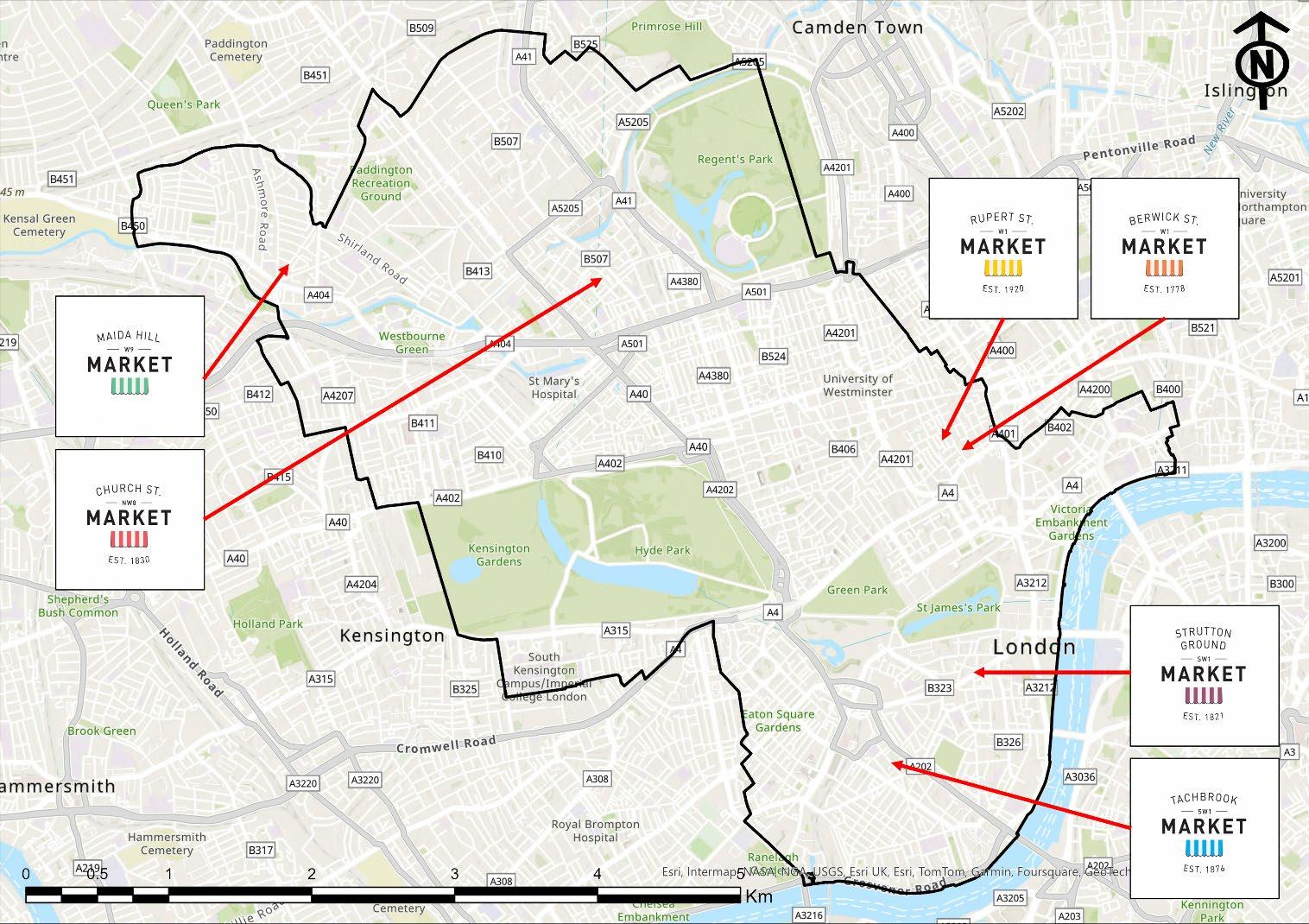
Markets are usually well serviced, temporary (i.e. not operating 24/7), involve street closures, and are controlled by the Westminster’s Markets Team within the council. Kiosks are more often permanently placed on the highway.
Permitted development rights exist under the Town and Country Planning (General Permitted Development) (England) Order 2015 (GPDO) for the holding of a market by or on behalf of a local authority. The purpose of this is to allow local authorities to operate markets as a means of promoting economic activity and supporting local communities without the need for planning permission, while also ensuring that the market is properly managed and does not cause undue harm to the surrounding area. The GPDO sets out the conditions under which a local authority may hold a market and the types of activities that are permitted as part of the market, including specifying the types of goods that may be sold, the hours of operation, and any restrictions on the frequency of the market.
Westminster City Council’s ‘Statement of Street Trading Policy’ sets out our approach to street licensing and its standards for those engaged in street trading either from an isolated pitch or within one of Westminster’s street markets. It outlines the common set of rules and how those rules will be applied. This policy also contains detailed criteria and guidance on the design of stalls, with details of stalls likely to be considered suitable and unsuitable for street trading.
Street Markets and Related Trading Guidance
A. Street markets should not have a detrimental impact on their setting in terms of visual amenity, noise and smells, physical obstruction, waste generation, and the economic success of their locality.
B. Paving materials used in street markets should be hard wearing and non-porous where there is a risk of staining from food and waste associated with the operation of the market/pitches. See Chapter 4.6 Paving Materials within this SPD.
C. Street trading should enhance, rather than detract from, the street in which it is located, in both design and goods on offer.
Temporary and semi-permanent kiosks
Context
In most cases non-temporary furniture and items on the public highway or forecourts, such as trading kiosks, require planning permission. Unlike markets, isolated kiosks can cause issues as they are usually not on closed roads, and some are permanently placed on the highway, so their design needs careful consideration. When poorly managed, they can have a negative effect on an area including causing obstructions for pedestrians, displaying excessive advertising, causing harm to the visual amenity of the area, and creating an untidy street scene.
It is considered that a single, well designed and located structure could have fewer negative impacts than clusters of smaller stalls, and as such may be preferable where it can be used to house several separate functions. Quick removal of structures may be necessary to facilitate highways works, street cleansing, or other works for special events in the public realm.
Policy 43 Public Realm in the City Plan sets out criteria for provision of new or replacement units and kiosks. (see Commerce in the Public Realm, Clause D above).
Temporary and Semi-Permanent Kiosks Guidance
Kiosks will only be permitted where they meet the criteria set out in the City Plan, as well as the guidance provided in ‘A Strategy for Westminster Council’s Markets 2019-2022’.
To minimise potential harm:
A. Semi-permanent kiosks will generally be resisted.
B. Where replacement facilities are proposed (including those in alternative locations to the existing), they should deliver net benefits by being designed and constructed in a manner that makes a positive contribution to their proposed setting and wider energy efficiency goals.
C. Stock should not spread onto the pavement.
D. Clusters of smaller stalls will generally be resisted.
E. Kiosks should be designed to include minimal advertising , no more than 10% of the stall can be used for advertising Ideally only a nonilluminated single fascia sign and menu panel. Planning conditions will be used to limit the number of advertisements that may be displayed on the structure
F. They should have regard available street space, pedestrian comfort levels, and potential for negative impacts on the highway caused by queues.
G. Due to flood risk, the use of in-ground power supply units should be avoided
‘Al
fresco dining’ / outdoor tables and chairs associated with licensed premises
Context
‘Al fresco dining’ is used to define tables and chairs placed outside premises, and linked to the commercial operation of those premises, for example to facilitate outdoor dining or drinking associated with licensed premises. Extending trading onto the highway, including through provision of outdoor seating, can help sustain businesses such as bars, cafes, and restaurants by increasing their trading space – at the expense of public access to this space. In the context of this guidance, the term is used to denote the footway and/or highway space allocated, as well as furniture and space requirement around outdoor tables and chairs. The demand for tables and chairs in the public realm is increasing and requires careful management.
Well-managed, commercial al fresco tables and chairs can enhance the utilisation of the public realm as a space for social interaction. However, this needs to be carefully balanced against the need to facilitate movement of pedestrians and other highways users, and the impact of associated noise to residents, occupiers, and other visitors.
Commercial activity can make an important contribution to the public realm; however it is a tertiary function to the primary function of the highway, which is the free and unobstructed movement of pedestrians, and secondary uses (e.g.
parking of vehicles, provision of cycle parking (including dockless), bus stop facilities, statutory undertaker equipment, SuDS etc).
Guidance for tables and chairs provided independently of commercial activities, for example in public squares and open spaces, is provided in Chapter 4.5 Street Furniture in this document
Chapter 5.2 Highways Space, Road safety and Parking in this document sets out pedestrian comfort levels and the corresponding minimum pavement widths generally required.
‘Al Fresco Dining’ / Outdoor Tables and Chairs Associated with Licensed Premises Guidance:
A. Al fresco dining and outdoor tables and chairs should be temporary, moveable structures and outside of permitted hours, the highway should return to its original use
B. Tables and chairs should not have a harmful impact on pedestrian comfort levels or desire lines
C. Priority will be given to pedestrian movements, and applications for tables and chairs will be considered in this context, having regard to potential impact on them.
D. Tables and chairs associated with commercial use will only be permitted in appropriate locations and at suitable times.
E. The function of the highway for passing and re-passing cannot be compromised to facilitate commercial activity.
F. The use of fixed structures, e.g. decking and permanent barriers to delineate space for al fresco dining will not generally be supported.
G. Consideration must be given to the impact of associated noise and disturbance to residents, occupiers, and other visitors
H. Internal storage for all items should be provided within the business unit.
I. Items should not be stored on the highway outside of permitted hours.
J. Some locations may require items to be removed from the highway while the business is trading to facilitate highway functions
K. When instructed by an appropriate council officer, items licenced for alfresco dining must be removed immediately
L. The use of the public highway for tables and chairs will be subject to review at all times given the changing demands upon the city.
M. Power provisions must be installed and assessed by a competent Highways electrician.
N. The instalment of power provisions should not allow trailing and overhanging cables and must not impact the safety of users or passersby
O. Licensees are responsible for all cost accrued from instalment and use of power supplies.
P. Generators and heating equipment will generally be resisted unless there is an identifiable need, this will be assessed by the council on a case-by-case basis.
Advice to applicants for pavement licences
Planning permission
The Business and Planning Act 2020 enabled applicants to apply for a pavement licence for tables and chairs and if granted, they would have deemed planning permission
The Levelling-up and Regeneration Act 2023 65 made provision to make the above arrangements permanent. Planning permission is generally not required for moveable tables and chairs, on the highway, however a pavement licence is still required
Businesses looking to place moveable tables and chairs on the highway are required to apply for a pavement licence and the licensing regime could condition such placement for limited periods of time. Where a licence is granted by the City Council, planning permission is deemed to have been granted. This is subject to a number of conditions. In some cases, for example, for furniture that is not removable and used in connection with the outdoor selling or the consumption of food and drink, planning permission may be required.
65 https://www.legislation.gov.uk/ukpga/2023/55
A pavement licence only permits the placing of tables and chairs within a defined area on the public highway. The licence does not permit businesses to fence off areas in front of their premises for dedicated smoking areas or for vertical drinking, to help minimise impacts on amenity and on the highway. For further information on licensing conditions please read Pavement Licence Conditions on the council’s website.
Planning permission is still generally required if businesses want to use the highway for any purpose other than placing tables and chairs. This includes al fresco dining areas which use the highway for vertical drinking, food preparation, or as a dedicated smoking area, with the exception of those activities allowed by the permitted development rights explained below which relate to moveable structures.
Where planning permission is required, this will be considered in line with City Plan policy 43 (see Commerce in the Public Realm above).
More information on pavement licences can be found on the council’s website 66 and the government’s website on Paving licences: guidance
When do businesses need a pavement licence?
Businesses looking to place tables and chairs outside their property need to apply for a pavement licence if the items are to be placed on any land either dedicated or adopted as public highway. Section 31 of the Highways Act 1980 states that if a path or way has been used by the public continuously for 20 years, legally it can be deemed as a public right of way without landowner objection. Privately owned land outside of premises which has been used for passing and re-passing uninterrupted for the past 20 years is considered to be public highway, and a pavement licence is required to place tables and chairs, and other authorised furniture. Even if Land Registry Title documents can demonstrate land ownership, a pavement licence may still be required if the land is considered to be public highway.
Key considerations for pavement license applications
The City Council will base its decision on whether to grant licences for tables and chairs associated with commercial activity with consideration for the following:
• The location and proximity of the tables and chairs in relation to the licensed premises, and the space proposed to be dedicated to trading. This includes the associated circulation space, access by serving staff and customers to and from that space and the serviced premises. Off-set or floating tables and chairs away from the immediate retail frontage will not be supported.
• The number of tables and chairs proposed relative to the space available.
• The space left for pedestrians and other highway users not using these facilities.
• The proposed maintenance arrangements of the tables and chairs, and the proposed hours of operation and storage arrangements for the tables and chairs when not in use.
• The proposed design of associated street furniture such as umbrellas, and the proposed space between items.
• The space between the above and any existing items in the footway, including trees, lamp posts and other street furniture, drainage gullies, and other features of the public realm.
• The location and proximity of any furniture to fire escapes, tactile paving, or utilities infrastructure.
• Photographs showing the site, and its surroundings can be helpful when we deal with applications for tables and chairs in the public realm.
Further guidance on tables and chairs and how applicants must minimise impact on the highway
Location
Location Guidance:
66 Apply for a pavement license: https://www.westminster.gov.uk/licensing/apply-pavement-licence
A. Tables and chairs may be permitted:
• In fully pedestrianised streets and public squares;
• In partially pedestrianised streets where vehicles are banned at certain times of the day;
• In streets with footways of adequate width and carriageway.
B. Tables and chairs will generally not be permitted outside stations, near pedestrian crossings, outside the frontage of the applicants' premises or other locations where they are likely to impede unobstructed movement.
C. The amounts of space that might be available for tables and chairs at the above locations are shown as an indicative guide in figures below
D. Larger canopies will only be allowed in suitable open areas where they will not clutter important local views48 (This includes Protected Vistas and Other Strategic Views identified in the City Plan, local views of metropolitan importance and other important views identified in neighbourhood plans or conservation area audits)
E. Canopies, umbrellas or other structures should not extend beyond the permitted area for tables and chairs
F. Canopies, umbrellas or other structures need to be removeable and should not be stored on the highway at night.

An indicative plan of a site with tables and chairs showing dimensions, proposals and premises details.
Placement, layout, and dimensions
Sufficient pavement space must be provided and maintained to allow all pedestrians, including wheelchair users, the elderly and those with prams and buggies to pass along safely and easily. Space must be provided to enable safe escape from premises, and access by the emergency services.
Placement, Layout and Dimensions Guidance:
A. Tables and chairs should generally be placed against the building and not kerb edge Tables and chairs off-set from the property frontage will generally not be allowed. Tables and chairs will normally only be allowed directly outside the premises at the back of the footway.
B. The layout should allow for the tables to be served or for customers to carry food and drink themselves without leaving the proposed area to be licensed. Where this is not possible, any seating area should be table service only.
C. In all locations an absolute minimum clear zone of at least 2 metres of footway width must be kept free of tables and chairs and other obstructions, in line with recommended footway widths. Neither is this area to be used to service tables. In most locations more than the 2 metres minimum clear width will be required to ensure highway primary functions can continue and the highway can support Active Travel modes. The minimum width of the clear zone of unobstructed pavement increases to 4 metres in streets with heavy pedestrian traffic or poorly scoring pedestrian comfort levels.
D. Where footways are very crowded the width of the clear zone may be determined on a case-by-case basis. This area is not to be used to service the tables. Some streets are so busy or so narrow that they are unsuitable for tables and chairs altogether.
E. Placement of tables and chairs should not obstruct the safe flow of pedestrians or impact desire lines, crossing points of access to other highway infrastructure (for example cycle stands and tactile paving).
F. Placement of tables and chairs should not obstruct cleansing and maintenance vehicles.
G. Furniture should be arranged to reduce opportunities for crime.
H. Associated umbrellas/temporary covers should not overhang footways or interfere with vehicle sight lines and traffic signs.
I. A 3.45 metre wide pavement is unlikely to be sufficient to enable the placing of tables and chairs and a sufficiently clear pavement for pedestrians to safely pass.
J. For practical and safety reasons it is considered inappropriate in principle, to install and operate tables and chairs where the available pavement depth is less than 1.45 metres measured from the building line (i.e. where the total available pavement depth is less than 3.45 metres). This is because it is unlikely this would allow enough space for people to be served unless the tables and chairs can be served directly from the doorway.
K. In streets which are pedestrianised or shared/single surface a minimum of 4 metres clear width should be maintained to ensure emergency vehicle access
L. In streets which are pedestrianised or shared/single surface generally only a maximum of 25% of the width of the street will be allocated to temporary tables and chairs use – provided other clear widths are also possible. (This allows the opposite side of the street to also have 25% and the remaining 50% is for highway movement and uses) No more than 50% of the footway and carriageway width should be taken over by commercial activities
M. No arrangement or layout should allow or support vertical drinking
N. The needs of those with disabilities should be considered. The layout should allow enough space for wheelchair users to manoeuvre – at least one chair available for replacement by a wheelchair. A minimum depth of 1 metre is generally required.
O. Space must be provided and allocated (as well as marked on drawings) within the retail/business unit for the storage of all items to be placed on the highway, to be stored outside of permitted hours. It should be clear this should not conflict with business operation (i.e. tables and chairs may need to be stored off the highway while the business itself is still open).
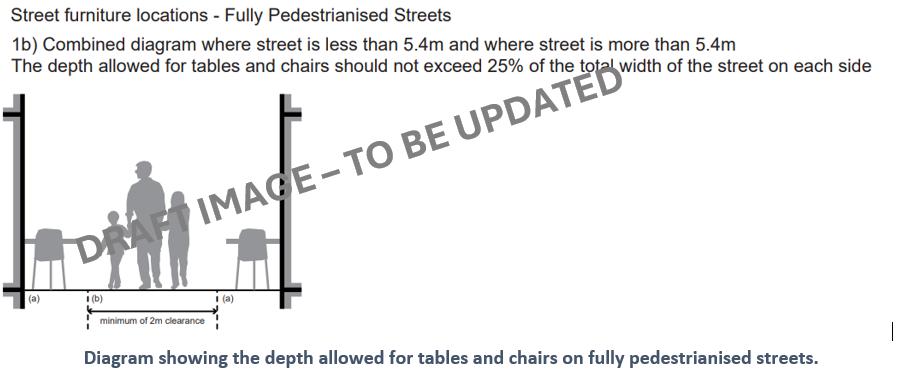

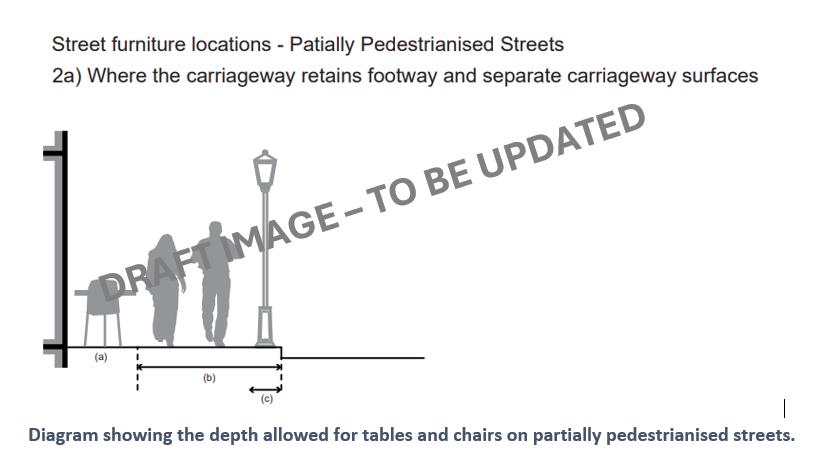
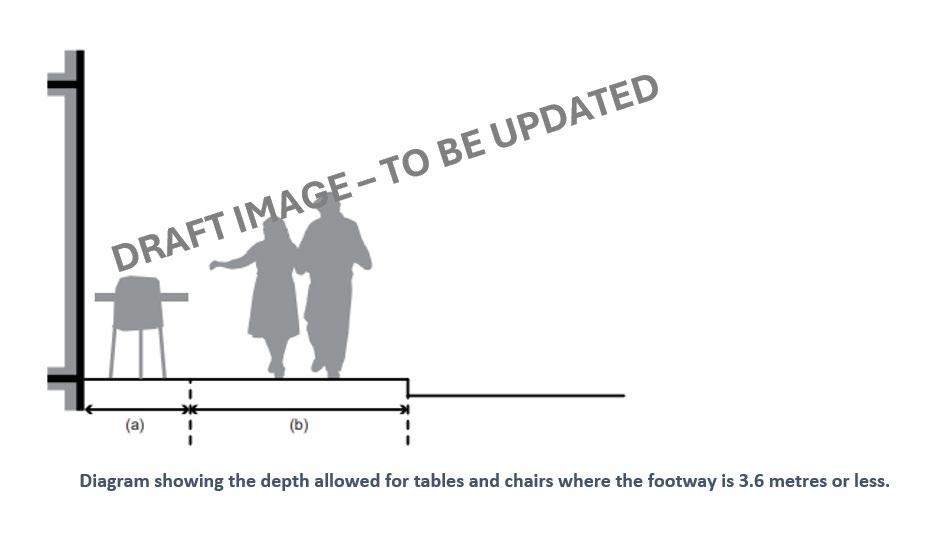
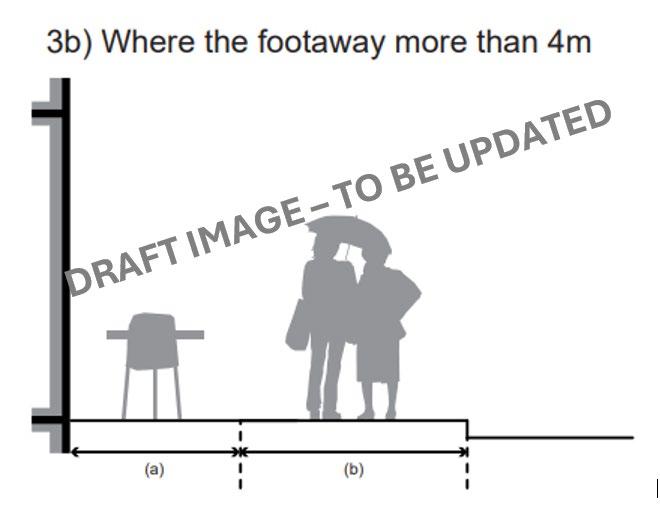



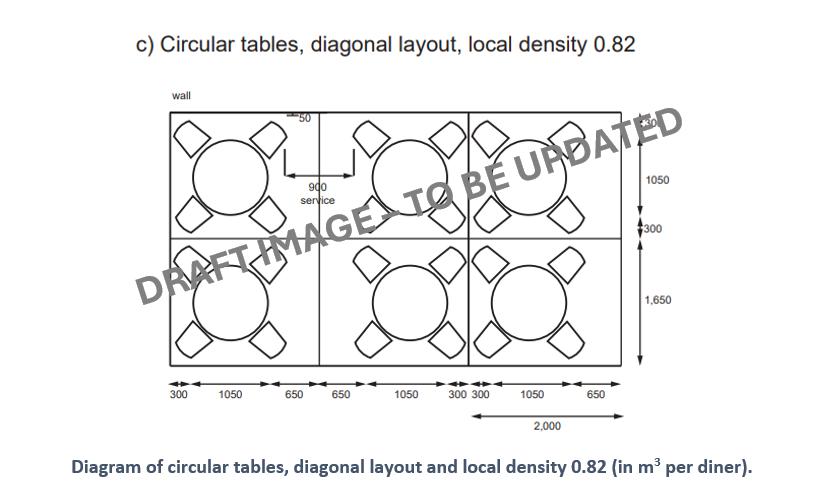
Management
Street furniture associated with tables and chairs such as space heaters, umbrellas and umbrella stands and barriers which require planning permission, are generally not acceptable. Such furniture provided when street trading rules were relaxed as an emergency response during lockdown measures in the early 2020s will be expected to be removed in line with permitted development and licensing agreements.
Management Guidance
A. Where provision of tables and chairs associated with commercial premises are supported on the highway, the tables and chairs will be required to be stored off-street outside of trading hours, so as not impede refuse storage and street cleaning. All tables and chairs and associated furniture and equipment must be removed and securely stored at night.
B. The cumulative impact of tables and chairs should not obstruct pedestrian desire lines, and cause zig-zag pathways along the highway.
C. Permanent barriers are not permitted, as the licensed area must be capable of reverting to use as public highway outside of the permitted licensed hours
D. Consideration should be given to the impact of “feet” of barriers on pedestrian movement. They should not obstruct or create a trip hazard.
E. Patio style gas space heaters will not be allowed in the public realm.
F. Electric radiant space heaters designed specifically for outdoor use may be allowed in the public realm with subject to risk assessment. The strong preference is for these to be sustainably powered.
G. Cable cover mats with rubber backing may be permissible subject to risk assessment.
H. Cables (including overhead) or mats should not be placed outside of the permitted tables and chairs area and should not cross pedestrian paths No trailing cables will be allowed.
General advice for tables and chairs
The following guidance about the design and management of furniture is offered to potential applicants. To avoid difficulties arising from tables and chairs it is strongly recommended that they consider the following:
Design expectations:
• Tables and chairs should be well designed and respect the character of buildings and settings. Furniture should be strong, stable, and durable enough for heavy use and is easily wiped down and dried after rain or cleaning.
• Muted tones and durable easy to maintain materials such as timber and steel are most likely to be most appropriate.
• Furniture with rubber feet should be used to help reduce noise associated with them being moved and damage to the pavement.
• Tables and chairs and related furniture / umbrellas should be stable enough to withstand strong winds.
• Tables and chairs and related furniture / umbrellas should generally be
• Umbrellas should be in a plain canvas material, capable of being folded down and removed.
• Plastic garden furniture is unlikely to be strong enough for constant use and could blow away and cause an accident. Its use is not recommended.
• Enclosures for tables and chairs should be easily distinguishable to passers-by.
• Security implications should be considered in the initial design and selection of furniture.
Event Spaces
The City of Westminster is home to some of the most iconic event locations in the world. Westminster’s streets and open spaces are the first choice for thousands of outdoor events, parades, and brand activations every year. Public spaces designed to host events should have suitable provision for power and water supplies as required, with ducting laid in anticipation of demand. Consideration should be given to the impact of barriers, temporary structures and plant equipment required for the event, with particular attention paid to the impact on highway users and residential amenity.
Material choices should reflect the proposed nature of events, and not include porous materials where food spills are expected.
Access requirements, including emergency and utility access should be designed into schemes. If necessary contingency plans should be arranged to ensure structures and barriers that may impede emergency access are easily movable
For temporary or permanent power supplies event organisers should discuss requirements with the Event team. Event organisers should submit a management plan to be reviewed by the council
For further information on power supplies for events, please see Chapter 4.12 Power and Lighting, within this SPD.
Events in the public realm
The City Council will work with you to plan a safe and successful event by securing your event date and location and offering advice on the permits and licences you will need. We will review your event management plan, risk assessment and other documentation.
Links and Related Documents and Strategies
Sources:
• Pavement licences guidance
• Guidance: pavement licences (outdoor seating) - GOV.UK (www.gov.uk)
Replacing existing Guidance contained in:
• Westminster Way SPD
• Tables and chairs SPG
